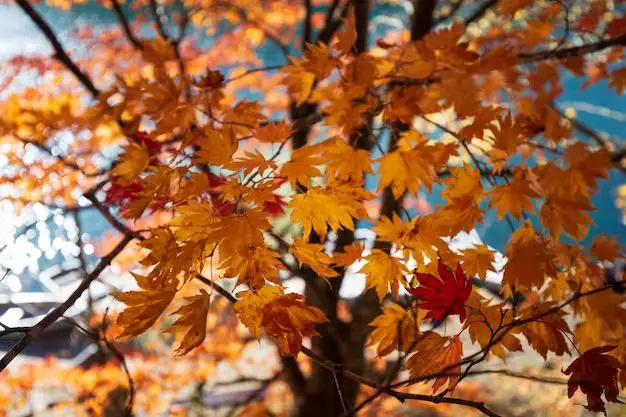Trees that have orange leaves in the fall are often a stunning sight. The bright colors stand out against the otherwise fading greens and browns. So what causes some tree leaves to turn orange in autumn? The answer lies in the chemical makeup of the leaves and the process of how they change prior to falling off the tree.
Page Contents
Why Leaves Change Color
Leaves get their green color from chlorophyll, which is essential for photosynthesis. In the spring and summer, leaves are full of chlorophyll to absorb sunlight and convert it into energy through photosynthesis. As autumn approaches, due to changes in the length of daylight and temperatures, the leaves stop their food-making process. The chlorophyll breaks down and the green color disappears.
This reveals the other pigments that have been present in the leaves all along, including carotenoids and anthocyanins. These provide the vivid yellow, orange, and red hues seen in fall foliage. The specific colors that emerge depend on the pigments present in each tree species.
What Makes a Leaf Turn Orange
For a leaf to turn orange, it must contain carotenoids. Carotenoids are organic pigments produced by plants. The most common carotenoids found in plant leaves are lutein, zeaxanthin, and beta-carotene.
Beta-carotene specifically provides bright orange and yellow colors. It absorbs blue and green light, reflecting wavelengths in the yellow to orange spectrum, creating those warm hues.
In some tree species, anthocyanins may also contribute to orange leaves. These red and purple pigments complement the yellow and oranges from carotenoids. The combination results in warmer, orangey reds.
Trees with Orange Fall Leaves
Here are some of the most common trees that display vibrant orange foliage in autumn:
Sugar Maple
The sugar maple (Acer saccharum) is renowned for its stunning fall colors. Its leaves transition from green to hues of orange, red, and yellow. The orange shades are primarily due to high concentrations of carotenoids in its foliage.
Red Maple
Red maples (Acer rubrum) are another type of maple valued for autumn displays. Their leaves can appear red, orange, or yellow depending on environmental conditions. Orange leaves occur when carotenoid levels are high.
American Sweetgum
The star-shaped leaves of the American sweetgum (Liquidambar styraciflua) turn multiple colors in the fall, ranging from yellow to deep purple. But most commonly they change to brilliant orange hues thanks to ample amounts of carotenoids.
Black Tupelo
The black tupelo (Nyssa sylvatica) is a deciduous tree that offers striking fall foliage. Its leaves transition from green to vibrant red, orange, or yellow. The orange shade is created by carotenoids.
Sourwood
Sourwood (Oxydendrum arboreum) is a small deciduous tree native to the eastern United States. In autumn its leaves reliably turn brilliant shades of red, orange, and yellow as chlorophyll breaks down to reveal carotenoids.
Other Factors Affecting Fall Leaf Color
The particular fall foliage colors that emerge depend on more than just the tree species. Weather and environmental factors also play a role, even on the same tree. Conditions that influence leaf pigments and ultimate autumn color include:
- Sunlight – More sunny days produce more intense colors. Cloudy weather results in more muted tones.
- Temperature – Cool (but not freezing) nights and warm sunny days bring out the brightest colors.
- Rainfall – Adequate moisture is important for vivid fall displays.
- Soil – Some soils provide more nutrients which contribute to brighter leaf pigments.
- Location – Northern regions tend to have more intense fall colors than southern regions.
The interplay of these various factors is why the same tree species can produce different shades in different years or locations. But you can generally count on certain tree types, like several maple species, to provide beautiful orange tones in autumn.
Conclusion
Orange leaf color in the fall is produced mainly by carotenoid pigments. Trees that commonly display orange fall foliage due to high carotenoid content include sugar maple, red maple, American sweetgum, black tupelo, and sourwood. However, seasonal conditions also influence the particular autumn colors that emerge each year. Bright orange leaves bring stunning beauty to the fall landscape.
